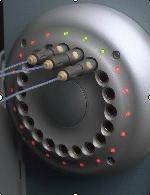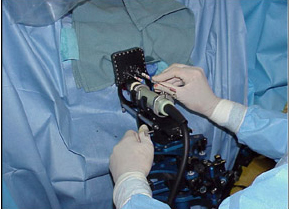Introduction to radiotherapy and prostate cancer
Radiotherapy is a form of treatment that is used to treat cancer of the prostate gland. It may be used alone or in conjunction with surgery. Radiotherapy involves the use of radiation which is targeted to the cancer site in order to destroy cancerous cells. Treatment is planned meticulously in order to minimise harm to normal cells. Treatment is usually carried out as an outpatient procedure, and lasts for several weeks (depending on the nature of the tumour). There are different forms of radiotherapy for the prostate available.
Radiotherapy fights cancer by using high energy radiation to destroy cancer cells that multiply rapidly. It prevents the cancer cells from multiplying and stops the cancer from growing larger. It is a commonly recommended form of treatment as it is less invasive than surgery, and does not carry as many risks as surgery does. During radiotherapy, patients will lie on a couch under a large x-ray machine. Each treatment lasts only for a few minutes and is not painful.
Forms of radiotherapy
There is a wide range of forms of radiotherapy in treating cancer of the prostate.
External beam therapy is divided into Standard External Beam Therapy and 3D Conformal Therapy. It delivers radiation beams targeted to the prostate, and is carried out as an outpatient procedure – patients do not have to stay in the hospital.
3D Conformal Therapy is a more updated method but is less widely available. It uses beams that are shaped to the outline of the prostate. Computer images are used to target the beams accurately.
Brachytherapy is a form of radiation therapy used in more localised prostate cancer, meaning cancer that is more confined to the prostate itself. In brachytherapy, the doctor implants radioactive seeds directly into the prostate. This enables the radiation to be given at a higher dose in a more concentrated manner.
Brachytherapy is a fairly short procedure. Patients are usually required to stay in the hospital for only one night.
High dose rate (HDR) brachytherapy
High dose rate (HDR) brachytherapy is usually combined with external radiotherapy. It is used to treat more advanced prostate cancer, where treatment is needed to cover the whole prostate and a margin.
In HDR brachytherapy, thin stiff plastic tubes are inserted through the perineum (the area of skin behind the scrotum) and into the prostate. This is done under anaesthesia. A radiotherapy machine inserts a radioactive wire through each plastic tube and into the prostate. These wires are left in place for a few minutes and then removed.
Patients stay in the hospital for one night. The next day the procedure of inserting and removing the radioactive wires is repeated. The procedure takes about half an hour.

| Figure 1: The machine used in HDR brachytherapy to insert radioactive wires through plastic tubes into the prostate. This is often used to treat more advanced prostate cancer. |
Seeding procedure
The seeding procedure is the procedure in brachytherapy in which radioactive seeds are implanted into the prostate to destroy cancer cells. Under anaesthesia, thin stiff plastic tubes are inserted through the perineum into the prostate. Radioactive wires are then inserted through the plastic tubes into the prostate, to implant radioactive seeds in the prostate.

| Figure 2: Radioactive wires are then inserted through the plastic tubes into the prostate, to implant radioactive seeds in the prostate. |
 |
 |
|
| Figure 3a: Unseeded prostate. The image of a prostate before implantation of radioactive seeds. | Figure 3b: Seeded prostate. The image of a prostate after the seeding procedure, where radioactive seeds are seen in the prostate gland. |
The radioactive seeds allow high dose radioactivity in the prostate to target cancer cells accurately while minimising damage to other body structures surrounding the prostate.
Advantages of radiotherapy
The option of radiotherapy as treatment for prostate cancer has the following advantages:
- It does not carry the risks of surgery, therefore it is useful in patients who cannot have surgery.
- It does not require long hospitalisation. Patients receiving external beam radiation does not even have to stay in the hospital – it is carried out as an outpatient procedure.
- Patients can return to normal life fairly soon, normally within a few days.
Disadvantages of radiotherapy
Disadvantages of radiotherapy:
- Tiredness, diarrhoea and cystitis (inflammation of the bladder causing a burning sensation when passing urine) are common short-term side effects.
- Damage to surrounding structures e.g. bladder, large bowel can sometimes occur, but this is uncommon as care is taken to minimise harm to structures other than the cancer cells.
- A small proportion of men (<5%) will have long-term bowel problems – bowel motions may become looser and more frequent. However, in most men these symptoms settle gradually.
- Patients receiving external beam therapy require frequent visits to the hospital radiothera
py unit as an outpatient for up to 6 weeks. - There is a risk of impotence (inability to achieve and maintain an erection) and urinary incontinence (leakage of urine).
- The skin in the area where the treatment is targeted may become sore.
More information
 |
For more information on prostate cancer, including diagnoses, types of treatments, and some useful tools, videos and animations, see Prostate Cancer. |
References
All content and media on the HealthEngine Blog is created and published online for informational purposes only. It is not intended to be a substitute for professional medical advice and should not be relied on as health or personal advice. Always seek the guidance of your doctor or other qualified health professional with any questions you may have regarding your health or a medical condition. Never disregard the advice of a medical professional, or delay in seeking it because of something you have read on this Website. If you think you may have a medical emergency, call your doctor, go to the nearest hospital emergency department, or call the emergency services immediately.







